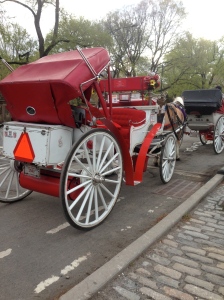Alexandra Summa is fighting to preserve a tradition. With New York City’s horse drawn carriage industry on the brink of termination, the 15-year-old activist is using her voice and the power of community activism to save what she believes is an important New York City tradition.
The Eleanor Roosevelt High School sophomore, who is a member of the National Honor Society, has lived on the Upper East Side all her life and has enjoyed carriage rides in the park for nearly as long. “I do not want to see a part of New York’s heritage, which was such a treasured part of my childhood, disappear senselessly,” said Summa in an interview.
After hours spent in Central Park’s stables and with several carriage drivers, Summa founded IconicNYC, a student activist group intent on keeping the horse drawn carriage system up and running.
“I decided I could play a small part in the debate and have my voice heard on this issue,” said Summa. “We use the group to reach out and connect with people.” The group mainly utilizes petitions and postcards preaddressed to the mayor to share its message.
Summa is one of many New Yorkers resisting Mayor Bill de Blasio’s efforts to ban Manhattan’s horse drawn carriages, an industry which brings in roughly $19 million annually. De Blasio, who stated throughout his mayoral campaign that he would eradicate the industry upon election, believes the working horses are treated inhumanely.
Although the mayor’s decision to eliminate horse drawn carriages has been hotly debated on a citywide scale, it (literally) hits close to home for Upper East Siders, many of whom are divided on the ban.
Naomi Semeniuk, an animal rights activist with the Coalition to Ban Horse Drawn Carriages, is fighting alongside the mayor to put an end to horse drawn carriages for good.
“These horrors just keep happening to these beautiful, suffering creatures we love so much,” said Semeniuk, an Upper East Side resident. Semeniuk, who also works to promote vegan lifestyles in the neighborhood, believes immediate action is necessary in order to halt the horse drawn carriage industry.
“We need an upsurge of compassion with radical change and humane education because we can no longer be a society that kills, maims and abuses animals,” added Semeniuk. “Ignorance kills and in this case there’s plenty of ignorance.”
According to The Humane Society, there have been dozens of documented accidents resulting in injuries and deaths of New York City’s carriage horses through the years, as well as records of insufficient veterinary care.
The horse drawn carriage debate is not a new one. However, in recent months the issue has garnered increased attention, in part due to the involvement of high profile advocates firing from both sides: the actor Liam Neeson has been outspoken in his efforts to keep the horse drawn carriage system alive, while actors Alec Baldwin and Lea Michele are campaigning publicly for a ban.
Although treatment of the horses is at the epicenter of debate, for those whose livelihood depends upon the horse drawn carriage industry, the issue extends beyond the condition of the animals.
Boris Majkut, 36, is one of approximately 130 carriage owners in Central Park. “I have been doing this since 2003,” said Majkut, who lives in Bayside, Queens. Majkut admits he hasn’t closely followed de Blasio’s efforts to abolish the industry, but hopes the mayor is sympathetic to those whose jobs will be lost if he follows through with the ban.
“I can tell you, the horses are treated well and they are in good health,” added Majkut. “This is my buddy,” he said, gesturing to the dark brown horse behind him, whom he calls Rocco.
While the continued existence of horse drawn carriages has left many Upper East Siders in contention with one another, some in the neighborhood believe the focus on the issue is a waste of government muscle.
“I can’t believe how much energy is being spent on this,” said Debra Blank, 59, a therapist who has lived on the Upper East Side for most of her adult life. “Maybe it’s inhumane to horses, maybe not, but what I do know is that there are people suffering right here in the neighborhood and we should place more value on that than the well being of horses.”
Yet, for those who do stand decidedly on either side of the issue, efforts will persist.
“There are simple things that can be done that would improve the quality of working conditions and safety for the horses,” said Summa. “No one supports animal abuse—these animals are well cared for. Unlike the mayor, I have visited the stables.”



